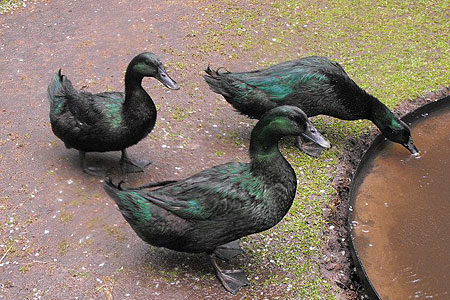
Mystery shrouds the origins of the Cayuga duck. Among the many legends, one claims the breed came from a pair of wild ducks in New York. Another claims the Cayuga derives from the ancient Black duck of Lancashire in the United Kingdom.
Whatever the case, the duck gets its name from a Native American tribe in New York’s Finger Lakes region. The Cayuga duck was admitted to the American Standard of Perfection in 1874.
Physical Attributes
The Cayuga is entirely black, including its bill, legs, and feet. In sunlight, however, the plumage has an iridescent green sheen.
As these ducks age their color gradually mottles with white, especially among the hens. Selective breeding against white feathers also selects against the characteristic iridescence, which then would be lost in future generations.
The feet of aging drakes may develop traces of orange, and their legs and bill may shade to dark olive. Mature drakes develop gender identifying curled feathers at the top of their tail.
Breed Qualities
Cayugas are among the hardiest of domestic ducks. They are excellent foragers and, given enough good hunting ground, can satisfy most of their own nutritional needs. They especially relish insects, snails, and slugs. But, because they don’t readily fly, free-range Cayugas may have trouble escaping predators.
Cayuga ducks are especially cold hardy. In warm weather, though, their black plumage absorbs heat from sunlight, so they need some shade.
This breed was once a popular meat and egg duck on New York farms. Cayugas mature rapidly. The hens reach 7 pounds live weight at maturity, the drakes grow to 8 pounds. For meat purposes, they are ready for harvest between 8 and 12 weeks of age.
Cayuga hens lay 100 to 150 medium to large eggs per season. The shells are white, covered with a black film early in the laying season that gradually becomes gray as the season progresses. The hens may brood, and when they do they are fair mothers.
The Cayuga is a relatively quiet, calm, and friendly breed. Thanks to their stunning color and their docile temperament, Cayuga ducks are especially popular at exhibition. For the same reasons, they make terrific backyard pets.
Helpful Links
- Keeping Ducks for Eggs
- How to Keep Your Ducks Laying Well
- How the Eggs of Chickens, Turkeys, Ducks and Geese Compare
- How to Handle Duck Eggs for Eating
And that’s today’s news from the Cackle Coop.
Gail Damerow is the author of An Absolute Beginner’s Guide to Raising Backyard Ducks : Breeds, Feeding, Housing and Care, Eggs and Meat.

